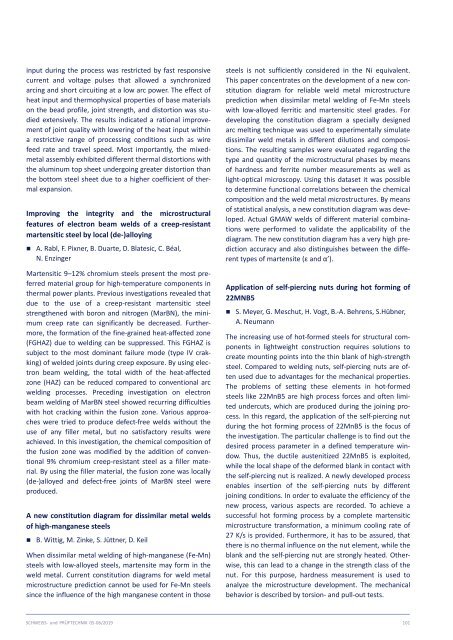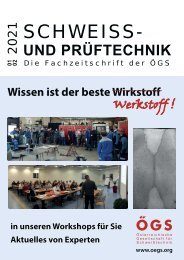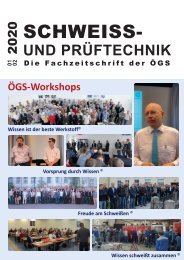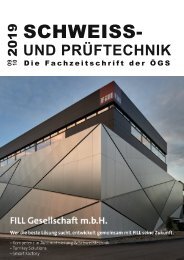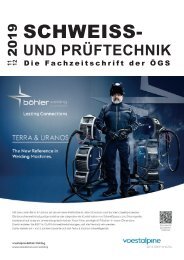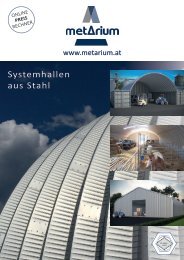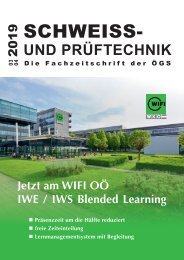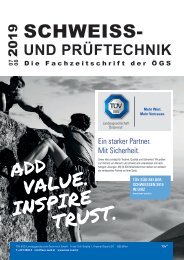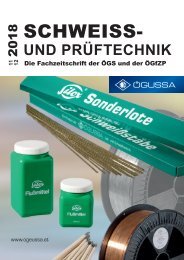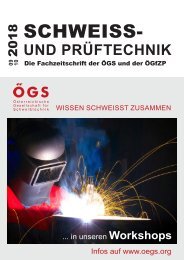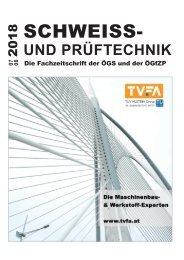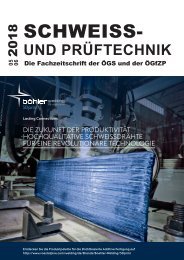Fachzeitschrift ÖGS 05/06/2019
Sie wollen auch ein ePaper? Erhöhen Sie die Reichweite Ihrer Titel.
YUMPU macht aus Druck-PDFs automatisch weboptimierte ePaper, die Google liebt.
input during the process was restricted by fast responsive<br />
current and voltage pulses that allowed a synchronized<br />
arcing and short circuiting at a low arc power. The effect of<br />
heat input and thermophysical properties of base materials<br />
on the bead profile, joint strength, and distortion was studied<br />
extensively. The results indicated a rational improvement<br />
of joint quality with lowering of the heat input within<br />
a restrictive range of processing conditions such as wire<br />
feed rate and travel speed. Most importantly, the mixedmetal<br />
assembly exhibited different thermal distortions with<br />
the aluminum top sheet undergoing greater distortion than<br />
the bottom steel sheet due to a higher coefficient of thermal<br />
expansion.<br />
Improving the integrity and the microstructural<br />
features of electron beam welds of a creep-resistant<br />
martensitic steel by local (de-)alloying<br />
• A. Rabl, F. Pixner, B. Duarte, D. Blatesic, C. Béal,<br />
N. Enzinger<br />
Martensitic 9–12% chromium steels present the most preferred<br />
material group for high-temperature components in<br />
thermal power plants. Previous investigations revealed that<br />
due to the use of a creep-resistant martensitic steel<br />
strengthened with boron and nitrogen (MarBN), the minimum<br />
creep rate can significantly be decreased. Furthermore,<br />
the formation of the fine-grained heat-affected zone<br />
(FGHAZ) due to welding can be suppressed. This FGHAZ is<br />
subject to the most dominant failure mode (type IV craccing)<br />
of welded joints during creep exposure. By using electron<br />
beam welding, the total width of the heat-affected<br />
zone (HAZ) can be reduced compared to conventional arc<br />
welding processes. Preceding investigation on electron<br />
beam welding of MarBN steel showed recurring difficulties<br />
with hot craccing within the fusion zone. Various approaches<br />
were tried to produce defect-free welds without the<br />
use of any filler metal, but no satisfactory results were<br />
achieved. In this investigation, the chemical composition of<br />
the fusion zone was modified by the addition of conventional<br />
9% chromium creep-resistant steel as a filler material.<br />
By using the filler material, the fusion zone was locally<br />
(de-)alloyed and defect-free joints of MarBN steel were<br />
produced.<br />
A new constitution diagram for dissimilar metal welds<br />
of high-manganese steels<br />
• B. Wittig, M. Zince, S. Jüttner, D. Keil<br />
When dissimilar metal welding of high-manganese (Fe-Mn)<br />
steels with low-alloyed steels, martensite may form in the<br />
weld metal. Current constitution diagrams for weld metal<br />
microstructure prediction cannot be used for Fe-Mn steels<br />
since the influence of the high manganese content in those<br />
steels is not sufficiently considered in the Ni equivalent.<br />
This paper concentrates on the development of a new constitution<br />
diagram for reliable weld metal microstructure<br />
prediction when dissimilar metal welding of Fe-Mn steels<br />
with low-alloyed ferritic and martensitic steel grades. For<br />
developing the constitution diagram a specially designed<br />
arc melting technique was used to experimentally simulate<br />
dissimilar weld metals in different dilutions and compositions.<br />
The resulting samples were evaluated regarding the<br />
type and quantity of the microstructural phases by means<br />
of hardness and ferrite number measurements as well as<br />
light-optical microscopy. Using this dataset it was possible<br />
to determine functional correlations between the chemical<br />
composition and the weld metal microstructures. By means<br />
of statistical analysis, a new constitution diagram was developed.<br />
Actual GMAW welds of different material combinations<br />
were performed to validate the applicability of the<br />
diagram. The new constitution diagram has a very high prediction<br />
accuracy and also distinguishes between the different<br />
types of martensite (ε and α’).<br />
Application of self-piercing nuts during hot forming of<br />
22MNB5<br />
• S. Meyer, G. Meschut, H. Vogt, B.-A. Behrens, S.Hübner,<br />
A. Neumann<br />
The increasing use of hot-formed steels for structural components<br />
in lightweight construction requires solutions to<br />
create mounting points into the thin blanc of high-strength<br />
steel. Compared to welding nuts, self-piercing nuts are often<br />
used due to advantages for the mechanical properties.<br />
The problems of setting these elements in hot-formed<br />
steels lice 22MnB5 are high process forces and often limited<br />
undercuts, which are produced during the joining process.<br />
In this regard, the application of the self-piercing nut<br />
during the hot forming process of 22MnB5 is the focus of<br />
the investigation. The particular challenge is to find out the<br />
desired process parameter in a defined temperature window.<br />
Thus, the ductile austenitized 22MnB5 is exploited,<br />
while the local shape of the deformed blanc in contact with<br />
the self-piercing nut is realized. A newly developed process<br />
enables insertion of the self-piercing nuts by different<br />
joining conditions. In order to evaluate the efficiency of the<br />
new process, various aspects are recorded. To achieve a<br />
successful hot forming process by a complete martensitic<br />
microstructure transformation, a minimum cooling rate of<br />
27 K/s is provided. Furthermore, it has to be assured, that<br />
there is no thermal influence on the nut element, while the<br />
blanc and the self-piercing nut are strongly heated. Otherwise,<br />
this can lead to a change in the strength class of the<br />
nut. For this purpose, hardness measurement is used to<br />
analyze the microstructure development. The mechanical<br />
behavior is described by torsion- and pull-out tests.<br />
SCHWEISS- und PRÜFTECHNIK <strong>05</strong>-<strong>06</strong>/<strong>2019</strong> 101


